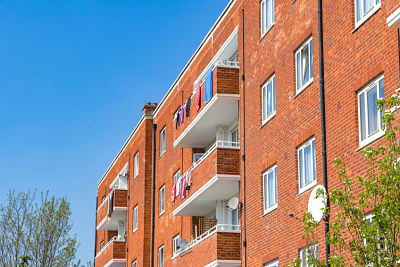
In an ideal world, most landlords would like to live near the rental properties they manage, enabling them to visit at the drop of a hat to carry out tasks like property viewings and maintenance jobs in person.
However, in reality, many landlords live a long way from their rental properties, sometimes even in a different country.
At times, distance can make simple management tasks complicated to perform. So, if you do find yourself managing a buy-to-let that you can’t quickly pop over to visit, it’s important to have a strategy in place to ensure that everything still runs like clockwork for your tenants.
In this article, we’ll learn about effective strategies and tools that landlords can use to manage rental properties from afar without impacting tenant experience or satisfaction.
Exploring the reasons behind long-distance property investment
You may be wondering why a landlord would invest in an out-of-town buy-to-let. While it may be more convenient to invest in a local property for management purposes, investing locally may not always make the most financial sense.
To maximise rental income, landlords should always consider which locations currently have the highest rental yields. If your local area has a poor rental yield, it may make more financial sense to invest in an area with higher rental yields, even if it does make property management a little more complicated.
Another reason someone may manage a rental property from afar is if they are an accidental landlord. That is, someone who didn’t set out to become a landlord but rather fell into the role through a series of unforeseen events. Some common factors that lead to a person becoming an accidental landlord include inheriting a property, being unable to sell their home, or temporarily relocating for work.
Whatever the reason, managing a long-distance rental property isn’t a problem as long as you implement a strategy to make it work.
The challenges of managing rental property remotely
If you want your rental business to work, the most important thing to keep in mind is that no matter how far you live from the rental property, your tenant should receive the same level of service as if you lived next door.
Keeping your tenants happy is key to your rental business’s success. After all, happy tenants are more likely to pay rent on time, look after your property, and stay longer.
If you manage a rental property remotely, you may face several challenges. Let’s find out more about what these could be.
- Maintenance and repairs – One of the biggest concerns landlords have about managing a long-distance rental property is what to do when things go wrong. If your tenants report that the plumbing has sprung a leak or the roof is falling down, it can be difficult and stressful to assess and resolve the situation from afar.
- Tenant management – If you live far away from your rental property, it is much more difficult to manage tenants yourself. You may not be able to meet or vet tenants in person and may feel like you’ve lost some autonomy over who you’re renting to. Inadequate tenant screening could also result in unreliable or problem tenants. Communication may also become more difficult if you live in a different timezone to your tenants; this could cause tenants to become frustrated or dissatisfied with the service you’re providing.
- Compliance with local laws – Rental laws vary between countries and even from one local authority to another. If you do not live in the same location as your rental property, it may require more effort to ensure that you are in the loop and complying with local laws and tax requirements.
- Property inspections – From time to time, it is important to perform routine property inspections to ensure that tenants are looking after your property and check if any maintenance or repairs are required. If you live far from the property, it may be impossible or inconvenient to carry this out yourself, so you’ll need to find someone reliable to carry out the task for you.
- Security – If you live close to your rental property, you can pop over during empty periods to check that it is secure and carry out maintenance tasks to keep it in good condition. If you are unable to do this, your property could be at risk of being broken into or falling into disrepair unless you arrange for someone else to help out with this job.
- Emergencies – In emergencies, your tenants will expect to receive an immediate response and assistance. If your distance to the property means that response times are delayed, it could result in significant damage to your property and unhappy tenants.
It’s important to iron out how you’ll handle all of the challenges listed above before you welcome your first tenants; otherwise, you risk starting your relationship off on the wrong foot. While it may sound like a lot, there are plenty of tools and services at your disposal that can help make life as a long-distance landlord much easier.
Strategies for managing a long-distance rental property
Essentially, you have two choices – hand the reins over to a local property management company or leverage the tools and services necessary to handle things effectively from a distance.
The right option for you depends on several factors, including your personal circumstances, budget, and business objectives. Let’s learn a little more about the pros and cons of each option.
Property management company
A property management company can manage every aspect of your rental business for you if you want them to. Similarly, a fully managed letting service can be used to take care of the day-to-day running of your rental business. If you want to take a hands-off approach or don’t have the time to manage the property, then this is the most hassle-free solution. These services can handle every aspect of managing your rental property, from marketing to tenant screening and property maintenance to tenant evictions.
On the one hand, this can seem like a very attractive option. You will have peace of mind that your rental property is being run by experts who can provide tenants with a local contact. However, hiring a property management company can be very expensive, especially if you require the full service. Not only will you lose control over how your rental business is being run, but paying for the service will also significantly impact your profitability.
Self-manage using the right services and tools
Self-managing your rental property is only an effective option for those who have the time to commit to it. Although it is perfectly possible to self-manage remotely, it requires strategy, time, dedication, and a willingness to learn how to use appropriate tools.
The benefits of self-managing include retaining autonomy over how your rental business is run and, of course, massive cost savings, which can boost your rental’s overall profitability.
The right option for you and your business is a personal decision. When deciding which route to take, it’s important to factor in which option you believe will provide your tenants with the best level of service, as well as which is more convenient and cost-effective for you.
Tips and tools for self-managing a long-distance rental property
If you decide that self-management is the way forward, it’s important to develop a strategy to help you overcome the challenges that your distance from the property may present. Luckily, if you’re willing to leverage technology, there are plenty of services and tools that can help you with this.
Let’s discover some top tips and tools for managing a long-distance rental business.
Employ local help
While many tasks can be effectively carried out remotely, some jobs will always need to be carried out in person, like showing tenants around the property and carrying out maintenance. Therefore, it’s important to designate a reliable local contact to be on call for these jobs. This could be a trusted friend, family member, or professional service.
Schedule routine property visits – Although distance may mean that you cannot be there for every property inspection and viewing, if it is convenient for you to schedule routine property visits, this can help strengthen your relationship with the tenant and assess and maintain the condition of your property.
Build a reliable local team of contractors – Having a team of reliable local contractors on speed dial makes it quick and easy to organise maintenance, repairs, routine servicing, or safety checks for your rental property. This can help ensure the quality of any work carried out and minimise disruption for tenants.
Use specialist landlord software – Specialist landlord software like Landlord Vision can help you optimise the management of a long-distance rental property. This type of software provides tools designed to automate and streamline many routine tasks, such as sending tenant communications, managing contacts and rent payments, and bookkeeping. Being organised and efficient is key to meeting tenant expectations and providing a high level of service even from a distance.
Use online document signing software – If you cannot sign tenancy agreements and other important documents in person with your tenants, an electronic signature tool is an excellent alternative. These tools enable you and your tenants to quickly and easily sign and send any PDF document electronically. This useful feature is included with the Landlord Vision software.
Offer a variety of communication methods—Different people prefer communicating in different ways. Where one tenant may prefer to pick up the phone, another may favour texting or emailing. Cater to different communication preferences by offering a wide variety of options—from Zoom and Microsoft Teams to WhatsApp or text messages. Making it easy and convenient for your tenants to reach out to you can help you maintain a good landlord-tenant relationship.
Maintain regular communication – Don’t be a stranger. Keep tenants in the loop with regular communications about upcoming inspections, maintenance tasks, or lease renewals. Demonstrating active remote management can increase tenant satisfaction and make tenants more inclined to reach out to you if they have an issue.
Screen tenants over the phone or video call – While you may employ the help of someone local to show tenants around, it’s important to have a one-on-one conversation with all prospective tenants to gauge their character and suitability for your rental property. If you can’t do this in person, the next best alternatives are phone or video calls. It’s also important to implement a thorough tenant screening process, including credit checks and collecting references from employers and previous landlords to verify the reliability of potential tenants.
Install a smart security system – If you can’t be there in person to check in on your rental property from time to time, then technology can help you keep an eye on it from a distance. Installing a smart security system can give both you and your tenant peace of mind that the property is safe and secure. However, bear in mind that any security systems installed should respect your tenant’s privacy and must not record inside the property. You should also have the sound turned off so as not to record private conversations. Recording inside the tenant’s home is a breach of their human rights and the law. Landlords who install security cameras must also ensure that they do so in compliance with data protection laws.
Managing tenants and rental property from another city or even a different country undoubtedly has its challenges. However, landlords facing this situation should not feel discouraged—this scenario is more common than many might expect! With careful planning, the right tools, and a clear strategy, long-distance property management is not only possible but also has the potential to be highly rewarding!



